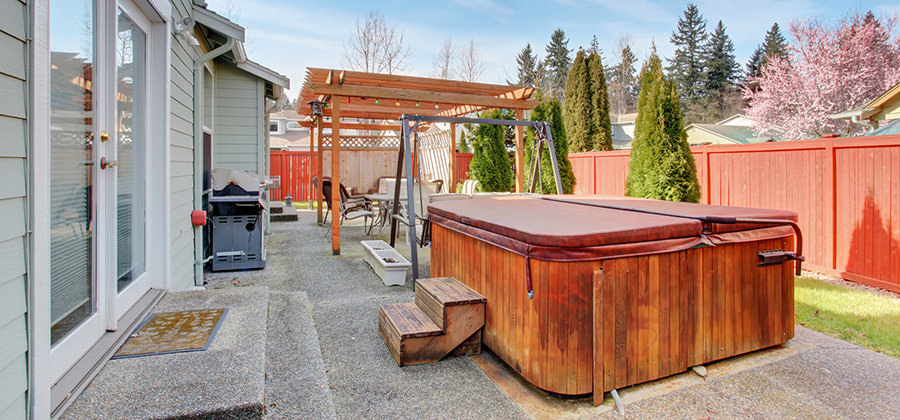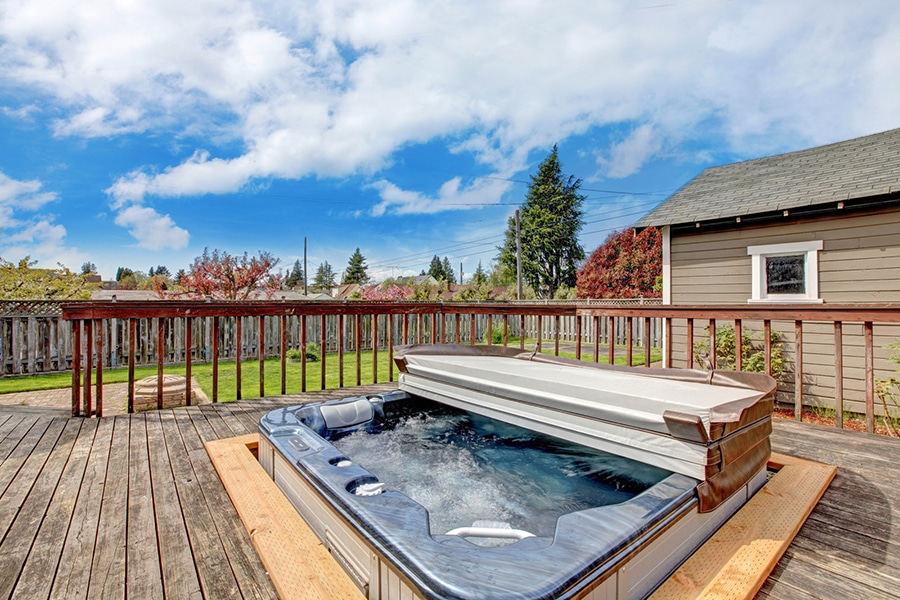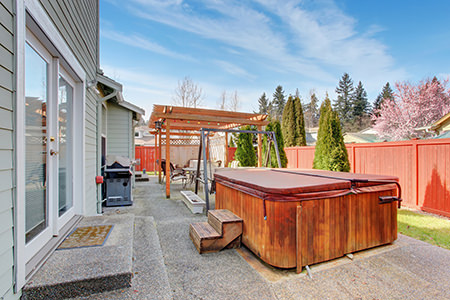
If your hot tub cover has become extremely heavy or difficult to lift the chances are that it has become waterlogged and needs drying out. If it is waterlogged it will also suck heat out of your hot tub 32 times faster than a dry cover. This means that at your hot tub will be costing you significantly more money to heat as well. Before you go out and buy a new hot tub cover it’s well worth trying to dry out your current cover to see if you can at least partly solve the problem. So, what are the steps you need to take to successfully dry out your hot tub cover and is it really worth the time and effort?
How to dry out a hot tub cover: Unzip the vinyl outer cover and remove the inner foam core. Dry off the vinyl cover thoroughly, clean it with an anti mould product and then leave out in the sun to dry thoroughly. Remove the vapour barrier from the foam core and place the foam core in the sun to dry. Raise off the ground to allow air to circulate. Re-cover with a vapour barrier before reassembling the hot tub cover and replacing it on the hot tub.
Why is my hot tub cover so heavy?
To really understand why a hot tub cover becomes waterlogged you need to know how the cover is constructed.
The Vinyl Covering – So, the bit of the hot tub cover that you see is usually made from marine quality vinyl – this is the outer cover and this holds the whole cover together. It’s the first line of defence against protecting the hot tub from the outside elements and also at keeping the heat from the hot tub in. The vinyl has to be well cared for and regularly conditioned to keep it in tip top condition and it is often treated with a UV treatment to help it stand up to the ravages of the sun. Underneath, it will probably have a treatment to repel the significant amount of high-temperature chemical barrage that the vapours from the hot tub throw at it.
The vinyl will probably have a zip which will allow you to disassemble the hot tub cover and it will also be fixed to the hinge and any other supporting mechanism that the hot tub cover has.
The foam core – At the very heart of a hot tub cover is the foam core. This is encased in the vinyl covering and it’s primary job is to make the cover as thermally efficient as possible – to keep warm air in and cold air out! Most foam cores have a slightly sloping profile to them to allow water and debris to fall off them. The foam cores in hot tub covers are available in a number of different densities with the most dense being the most thermally efficient and obviously also the most expensive!
The Vapour Barrier – The foam core is essentially comprised of millions of little air pockets which, if exposed to moisture will fill up with water. The foam core will basically act like a huge sponge and the moisture will ruin it’s insulating properties and make it extremely heavy. To prevent this happening the foam core is wrapped up inside a thin vapour barrier which is essentially a sealed sheet of plastic which stops any moisture from entering the core.

What’s the problem with a heavy hot tub cover?
Once a hot tub cover starts to draw in moisture it will get heavier and heavier as the water level increases. In the first instance, this will not be too much of a problem in terms of moving the cover but, with even a small amount of moisture in it, the hot tub cover will be significantly less thermally efficient and will start to lose it’s insulating properties. Bear in mind that hot air rises and that the hot tub cover is vital in keeping your hot tub warm. Any problems in this area are going to cause significant increases in the amount of energy it takes to keep the hot tub warm and this will, in turn, lead to increased energy bills. This is particularly true if you live in a cold climate or you keep your hot tub on all of the time and all year round.
The second issue is that a waterlogged hot tub cover will become increasingly heavy. It may get to the stage where you might not be able to remove it without help or the risk of injury due to straining to lift it, or the possibility of it slipping off the hot tub and hurting you. There is also a high chance that if you have a hot tub lifter it will warp or break with the extra weight. The hinge in the middle of the cover may well become damaged with the extra strain and you could even risk damaging the hot tub itself if the cover becomes too heavy or damaged.
Is it worth trying to dry out a hot tub cover or should I just buy a new one?
The problem is that hot tub covers are expensive. However, you do need to balance up the cost of either purchasing a cheaper quality one or of using a waterlogged cover against the significant extra cost of the energy you will need to use to heat your hot tub. Sometimes it is just best to cut your losses and to buy a new good quality cover. In the long run, it will save you on energy bills and will last significantly longer than a cheaper model.
Having said that though, if you don’t use your hot tub all the time or your cover isn’t seriously waterlogged then it is a good idea to at least try to have a go at drying it out. At the very least you might be able to get a few more months use out of it or you may well be able to work out if it’s possible to replace the foam cores and avoid the cost of a whole new cover.
Please be aware though that a number of people find that they simply cannot get all of the water out of a waterlogged foam core. Even after leaving it in the sun for several days or more to dry there is little improvement. It will, of course, all depends on the type and age of foam core you have, how much water is in it and the prevailing drying conditions. However, you haven’t really got anything to lose by trying to dry out a hot tub cover so why not give it a go? Here’s what to do:

How can I dry out a waterlogged hot tub cover?
Drying out a waterlogged hot tub cover isn’t particularly difficult. If you want to have a go then follow the step by step guide below.
Check for replacement parts – First of all, it is a good idea to see if you can purchase replacement parts for your cover. Can you get new foam cores for example? How will you replace the vapour barrier and what happens if the hinge or other parts of the cover break or disintegrate whilst you take it apart? At least if you know that you can’t get replacement parts you know where you stand and what you have to lose if things don’t go quite to plan!
Choose a dry sunny day – You need a warm, dry and sunny day to dry out your hot tub cover. There isn’t really any point in trying to do this when it’s pouring with rain! Preferably, try to find a time when there is a good few days of warm dry weather forecast as it is likely to take quite a while to dry out a really waterlogged core. The better the weather is the more success you are likely to have!
Remove the cover – Take the cover off the hot tub and also remove it from the cover lifter if you are using one. This may well be a two or more person job, particularly if your cover is really heavy. Do not attempt to do this yourself if you know that the hot tub cover is too heavy as it will only increase the risk of injury to either yourself or the hot tub cover!
Unzip the vinyl cover – Carefully unzip and remove the vinyl cover. Take care when doing this as any small areas of damage or tears could quickly become large ones if you just pull them in the wrong direction.
Remove the foam core – Once the vinyl cover is undone you should be able to remove the foam cores. These will be heavy and full of water so do this on the ground. Again it might take two people, one to hold the vinyl cover and one or more to pull the foam cores clear. Take care with them and bear in mind that they will be easily damaged if dropped.
Remove the vapour barrier – The core should be wrapped in a vapour barrier. If the core is heavily waterlogged the chances are that the vapour barrier will be damaged and be letting in moisture so it’s OK to remove it. Also, the core won’t dry out with the vapour barrier covering it so you need to remove it. As mentioned above you will need a plan on how to reinstate it – are you going to repair it, replace it with new plastic sheeting or heat seal the foam cores inside? Whatever you do the vapour barrier needs to be 100% waterproof when you put it back on.
Clean and dry the cover – Next, you need to thoroughly clean and dry the cover. Use a specialist mould remover if you need to and get everything as clean and dry as you can. An old towel will remove the obvious water but you will also need to put the whole cover out into the sun for an extended period of time to dry.
You may well be able to dry out the vinyl cover fairly easily by just folding it in and out and moving it’s position but the foam core may be more difficult. It’s a good idea to get a good circulation of air around it so standing it off the ground on two or three planks of wood is a good plan. Change the position of the core every so often to give the water chance to drain out and test to see if it feels any lighter to assess progress. It may dry out fairly well or you might need to wait several days. It’s also possible that leaving it out will make very little difference and you will have to resort to buying a new foam core or complete hot tub cover.
Check the vinyl cover for damage and repair – Once the vinyl cover is clean and dry you can do a thorough inspection for damage and repair or replace as necessary. It’s important that there aren’t any holes or rips in the vinyl cover as these will quickly become bigger and more problematic.
Reapply the vapour barrier – You then need to re-apply the vapour barrier to the core. This is vital as any holes in it will allow moisture to enter and it will quickly collect in the core leaving you back with a waterlogged cover! The vapour barrier doesn’t have to be replaced or repaired in a particularly scientific way. Wrapping with good quality plastic and sealing thoroughly will do the trick but take your time and get the barrier laid evenly and thoroughly sealed.
Replace the foam core – Now you can replace the foam core into the vinyl cover and reassemble the cover before putting it back on the hot tub or in the cover lifter.

How to prevent your hot tub cover from becoming waterlogged in the first place.
Prevention is better than cure so here are a few ideas to help prevent your hot tub cover getting waterlogged in the first place:
Buy a good quality cover – It goes without saying that the better quality the cover, the longer it will last before becoming waterlogged. All covers will take on some moisture eventually but a good quality cover will have high-quality vinyl and seams and, most importantly, a highly effective vapour barrier. It really is worth paying the extra for a thicker vapour barrier and asking to see if there is a warranty against water invasion as well.
A more expensive cover will last longer and will also insulate the hot tub more efficiently throughout it’s life as well. It is highly probable that, throughout the course of it’s life, it will easily pay for the extra investment as well as more savings on top.
Treat the vinyl cover regularly – The vinyl cover is the first line of defence against moisture and so you should treat it regularly and keep it clean and in good condition. The underneath suffers a barrage of hot vapours and you need to make sure that it doesn’t start to grow mould or become damaged. Similarly, the upper half of the vinyl cover needs to be kept supple and protected against the elements by using a special vinyl conditioner.
Remove the cover after adding chemicals – Remember to keep the cover off the hot tub for a while after shocking the tub or adding chemicals. The intensity of the vapour at this time can be extremely damaging for the underneath of the cover and it is far better to leave the hot tub open to the atmosphere.
Regularly dry the cover – Get into the habit of regularly taking the hot tub cover right off the hot tub and putting it out to dry in the sun and where there is good air circulation. Doing this on a weekly basis can considerably slow down the build-up of moisture and greatly add to the life expectancy of the cover.
Regularly inspect the cover – Look carefully for any holes or damage and as soon as you spot any problems make a repair. Damage to hot tub covers has a habit of getting worse the longer you leave it and any holes in the vinyl cover or the vapour barrier will allow moisture to enter the core and lead to waterlogging.

